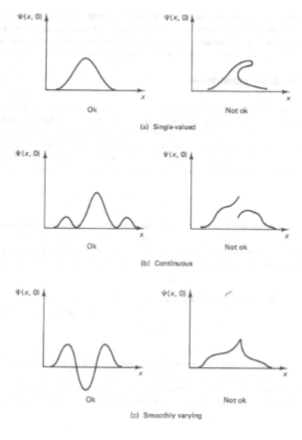“Probably your question is not that relevant”
- Dr Persans “You should prove that” -Dr Persans “Formal.” -Dr Persans
Set of all solutions are orthonormal
Sin and cosine functions follow this property too
Where
This is the Fourier transform
“my question is…” -Persans
We can use Euler’s equation to rewrite the Fourier transform
“It might be” -Persans
Gaussian pulse example
We can think of a Gaussian pulse as a localized pulse, whose position we know to a certain accuracy
Normalizing this function such that integrating over all x is 1 we get
“We’re not mathematicians, we’re physicists, so we’re going to be somewhat practical about this” -Persans
Finding the transform
I will drop overall multiplicative constants because I am interested in the shape of
letting
Heisenberg Uncertainty Principle
The standard deviation of k
The result is that $\sigma_{x}\sigma_{k}=1$ for a Gaussian pulse
is the wave-number, defined as . Also can be a vector to determine wave direction. The product of the wave-number width and spatial width is always equal to or greater then 1. The deBroglie hypothesis relates wavelength to momentum, deBroglie hypothesis
Applying the deBroglie hypothesis to the above principle we get the following:
Which is the Heisenberg Uncertainty Principle! It is frequently thought of as a measurement “problem” where you cannot know the position and momentum of a particle to an arbitrary accuracy simultaneously.
Conjugate variables
- Position and momentum are called conjugate variables and specify the trajectory of a classical particle
- If one wants to specify the position of a Gaussian wave packet, then:
- The Heisenberg uncertainty principle itself is uncertain.
Single Photon Experiments
- When single particles are sent through a system, there is interference even though there is no way for interference to occur with single particles.
- The wave function takes all possible paths at once, which is cool and weird. The wave function interferes with itself, which allows an interference pattern to form.
- If a measurement of which path the particle takes is done, the interference pattern is destroyed.
- Leads to many-worlds hypothesis. Quack science but interesting to look into. See the book timeline
Normalized Probability
- Given the probabilities for a set of outcomes, we can find useful quantities, like the average* (or expectation value) of a result q
- Variance = Dispersion average=mean=expectation value
Continuous Distributions
Finding expectation value Normalize first!!!
Superposition
If you have two functions and , two physically realizable states of a system, then the linear combination is also a possible state.
Normalization
Sometimes you have to normalize functions yourself that lead to an integrated probability that is not already 1. MAKE SURE YOUR FUNCTIONS ARE NORMALIZED
Schrodinger equation
There are relativistic forms of this equation. See Dirac Equation. Exists in 1d, 3d, time dependent, and time independent flavors. Time independent also known as energy eigenvalue equation.
Physical Constraints on wave functions
- has to be normalizable (gotta exist somewhere)
- has to be single-valued (cant have two probabilities at same point )
- has to be continuous (or you’ll have infinite energy)
- no kinks!
Examples of Wave functions

Expectation values
- Operators, quantum mechanics, etc etc etc